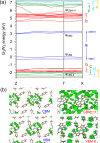Nature of Optical Excitations in Porphyrin Crystals: A Joint Experimental and Theoretical Study
- PMID: 33428409
- PMCID: PMC8023704
- DOI: 10.1021/acs.jpclett.0c03581
Nature of Optical Excitations in Porphyrin Crystals: A Joint Experimental and Theoretical Study
Abstract
The nature of optical excitations and the spatial extent of excitons in organic semiconductors, both of which determine exciton diffusion and carrier mobilities, are key factors for the proper understanding and tuning of material performances. Using a combined experimental and theoretical approach, we investigate the excitonic properties of meso-tetraphenyl porphyrin-Zn(II) crystals. We find that several bands contribute to the optical absorption spectra, beyond the four main ones considered here as the analogue to the four frontier molecular orbitals of the Gouterman model commonly adopted for the isolated molecule. By using many-body perturbation theory in the GW and Bethe-Salpeter equation approach, we interpret the experimental large optical anisotropy as being due to the interplay between long- and short-range intermolecular interactions. In addition, both localized and delocalized excitons in the π-stacking direction are demonstrated to determine the optical response, in agreement with recent experimental observations reported for organic crystals with similar molecular packing.
Conflict of interest statement
The authors declare no competing financial interest.
Figures




References
-
- Zhang G.; Chen X.-K.; Xiao J.; Chow P. C. Y.; Ren M.; Kupgan G.; Jiao X.; Chan C. C. S.; Du X.; Xia R.; et al. Delocalization of Exciton and Electron Wavefunction in Non-Fullerene Acceptor Molecules Enables Efficient Organic Solar Cells. Nat. Commun. 2020, 11, 3943.10.1038/s41467-020-17867-1. - DOI - PMC - PubMed
-
- Alvertis A. M.; Pandya R.; Muscarella L. A.; Sawhney N.; Nguyen M.; Ehrler B.; Rao A.; Friend R. H.; Chin A. W.; Monserrat B. Impact of Exciton Delocalization on Exciton-Vibration Interactions in Organic Semiconductors. Phys. Rev. B: Condens. Matter Mater. Phys. 2020, 102, 081122(R)10.1103/PhysRevB.102.081122. - DOI
-
- Nwachukwu F. A.; Baron M. G. Polymeric Matrices for Immobilising Zinc Tetraphenylporphyrin in Absorbance Based Gas Sensors. Sens. Actuators, B 2003, 90, 276–285. 10.1016/S0925-4005(03)00047-9. - DOI
-
- Min Park J.; Lee J. H.; Jang W.-D. Applications of Porphyrins in Emerging Energy Conversion Technologies. Coord. Chem. Rev. 2020, 407, 213157.10.1016/j.ccr.2019.213157. - DOI
LinkOut - more resources
Full Text Sources
Other Literature Sources
Research Materials
Miscellaneous

